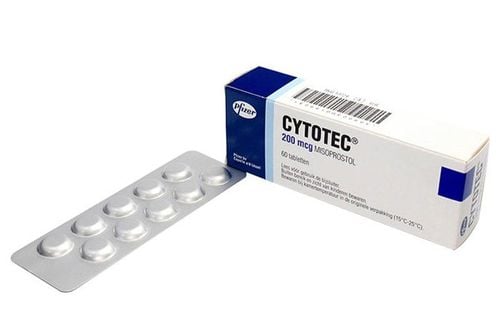This is an automatically translated article.
Vacoomez 40 is indicated in the treatment of gastric and duodenal ulcers, gastroesophageal reflux disease, ... What does Vacoomez do, how to use it, let's find out the uses of Vacoomez. 40 through the article below.
1. What is Vacoomez drug?
Active ingredient: Omeprazole
Brand name: Vacoomez
Drug group: Digestive medicine
Dosage form: Hard capsule containing enteric coated microparticles
Manufacturer: Vacopharm Pharmaceutical Joint Stock Company
Packing: Box of 10 blister, 20 blisters, 50 blisters, 100 blisters x 10 tablets; Bottle of 100 tablets, 200 tablets, 500 tablets, 1000 tablets
2. Uses of Vacoomez 40
Indications:
Gastroesophageal reflux disease (GERD). Treatment of gastrointestinal ulcers. Zollinger-Ellison syndrome. Dosage - Administration
The drug should be swallowed whole and should not be crushed or chewed.
Relief of acid indigestion symptoms: 10 or 20 mg/day for 2-4 weeks.
Treatment of gastroesophageal reflux syndrome (GERD): Usual dose: 20 mg x 1 time / day for 4 weeks, an additional 4-8 weeks if not completely cured. In cases of persistent esophagitis, a dose of 40 mg/day may be used. The maintenance dose after healing of esophagitis is 20 mg once daily and for acid reflux is 10 mg/day. Treatment of peptic ulcers: Single dose: 20mg/day, or 40mg/day in severe cases. Continue treatment for 4 weeks for duodenal ulcers and 8 weeks for gastric ulcers. Maintenance dose: 10-20 mg x 1 time/day.
For the eradication of Helicobacter pylori in peptic ulcers: Omeprazole can be combined with other antibiotics in dual or triple therapy. Dual therapy: Omeprazole 20 mg twice daily for 2 weeks. Triple therapy: Omeprazole 20 mg twice daily for 1 week. Treatment of gastric ulcers caused by non-steroidal anti-inflammatory drugs: 20 mg/day; A dose of 20 mg/day is also used for prevention in patients with a history of gastrointestinal injury requiring continued non-steroidal anti-inflammatory drug therapy.
Zollinger-Ellison syndrome: 60 mg once daily, adjusted as needed. Most patients are effectively controlled at doses ranging from 20 to 120 mg/day, but doses up to 120 mg 3 times/day can be used. Doses above 80 mg per day should be divided into 2 doses. Prevention of acid aspiration during general anesthesia. Dose of 40 mg the evening before surgery and an additional 40 mg 2-6 hours before the procedure. Patients with impaired renal function: No dose adjustment is required in patients with impaired renal function. Patients with liver failure: 10-20 mg/day. Elderly (> 65 years): No dose adjustment is required in the elderly. Children: Experience in the treatment of omeprazole in children is limited.
3. Side effects of the drug Vacoomez 40
Common:
Headache, drowsiness, dizziness. Nausea, vomiting, abdominal pain, diarrhea, constipation, abdominal distension. Uncommon:
Insomnia, confusion, dizziness, fatigue. Urticaria, itching, rash. Increased transaminases (reversible). Rare:
Sweating, peripheral edema, hypersensitivity including angioedema, fever and anaphylaxis. Leukopenia, thrombocytopenia, reduction in whole blood cells, agranulocytosis. Reversible confusion, agitation, depression, hallucinations in elderly patients and especially in critically ill patients, hearing disorders. Large breasts in men. Gastritis, Candida infection, dry mouth. Jaundice or non-jaundice hepatitis, encephalopathy in people with liver failure. Bronchospasm. Joint pain, muscle pain. Interstitial nephritis.
4. Notes when using Vacoomez 40
Contraindications:
Hypersensitivity to omeprazole, esomeprazole, or other benzimidazole derivatives (e.g. lansoprazole, pantoprazol, rabeprazole) or to any of the excipients.
Notes and cautions:
If the patient has symptoms such as a lot of weight loss, prolonged vomiting, difficulty swallowing, vomiting blood or black stools), suspected or is having a stomach ulcer, it is necessary to rule out the possibility that melanoma because treatment can alleviate symptoms and delay diagnosis.
The combination of proton pump inhibitors (PPIs) and atazanavir is not recommended. If coadministration of PPIs and atazanavir is deemed necessary, close monitoring of clinical manifestations (e.g. viral infection) is required in combination with increasing the dose of atazanavir to 400 mg and 100 mg of ritonavir, the dose of omeprazole should not be increased.
Like other acid blockers, omeprazole may decrease the absorption of vitamin B12 (cyanocobalamin) due to a decrease or lack of hydrochloric acid. Therefore, this factor should be considered in patients with reduced body stores or at risk of reduced vitamin B12 absorption if treated for a long time.
Omeprazole is a CYP2C19 inhibitor. When starting or ending treatment with omeprazole, the risk of drug interactions with drugs metabolised by CYP2C19 should be taken into account. When monitoring drug interactions between clopidogrel and omeprazole, the clinical correlation of this interaction is not clear. As a precaution, however, clopidogrel and omeprazole should not be used concurrently.
Severe hypomagnesaemia has been reported in patients treated with PPIs for at least 3 months and in most cases for about 1 year. Symptoms of severe hypomagnesaemia may occur such as fatigue, muscle spasticity, delirium, convulsions, dizziness, and ventricular arrhythmias, but these symptoms may be insidious and go unnoticed. In the majority of patients with hypomagnesaemia, the condition improved after magnesium supplementation and discontinuation of PPIs.
It is advisable to measure magnesium levels before initiating therapy and periodically during treatment in patients requiring long-term therapy or requiring concomitant PPIs with digoxin or other hypomagnesaemic agents (e.g. Diuretic).
Use of PPIs, especially at high doses and for a long time (> 1 year), may slightly increase the risk of hip, wrist, and spine fractures, mainly in the elderly or in the presence of: other risk factors. Observational studies have shown that PPIs increase the overall risk of fracture by 10 to 40%, in some cases possibly due to other factors. Patients at risk for osteoporosis should be cared for according to currently available clinical guidelines and should be adequately supplemented with vitamin D and calcium.
Note in pregnant women and nursing mothers
Pregnant women: Although in experimental studies, omeprazole did not have the potential to cause malformations and toxicity to the fetus, but should not be used for pregnant women. especially in the first 3 months.
Lactation: The use of omeprazole is not recommended in nursing mothers.
Omeprazole has virtually no effect on the ability to drive or use machines. Undesirable effects such as dizziness and visual disturbances may occur. At that time, the patient should not drive or operate machinery.
Please dial HOTLINE for more information or register for an appointment HERE. Download MyVinmec app to make appointments faster and to manage your bookings easily.













